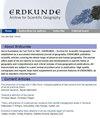Traces of past bog burning culture in rewetted bog soils (Emsland region, Germany)
IF 1.1
4区 社会学
Q3 GEOGRAPHY
引用次数: 0
Abstract
Until the beginning of the 20th century, bog burning culture was a common cultivation system for food production on otherwise non-arable bog peat soils. Burning and preliminary drainage of the peat impacted the soils nutrient supply, bog morphology and soils properties. To gain insights into the long-term effects of bog burning culture on the landscape and soils, a burned and unburned area within a rewetted bog complex were comparatively analysed. It was hypothesised that bog burning had a lasting effect on the soil chemistry, that the trenches created for drainage prior to burning are still detectable in the bog morphology, and that the altered soil chemistry exhibiting enhanced nutrient supply resulted in a change of vegetation patterns. To verify this, the soil chemistry was analysed regarding pH, carbon/nitrogen (C/N) ratio, and contents of plant available phosphate (PO43-) and potassium (K). The morphology was examined by means of aerial imagery and vegetation patterns were assessed in the field. It was shown that while PO43-- contents were similar, pH values and K contents of the burned area were elevated compared with the unburned area. Accordingly, they can be used as an indicator for bog burning culture, even a century after the end of the practice. As expected, C/N ratios were narrowed in the burned area, which however cannot exclusively be attributed to bog burning, since peat mineralisation in the previously drained bog soils caused narrowing C/N ratios as well. The trench structure for drainage was still visible in aerial images and vegetation patterns were similar in the burned and unburned areas. Overall, the aftermath of bog burning was still apparent in morphology and soil chemistry, however the effect was less severe than expected, as vegetation patterns and the overall restoration success were not impacted. This provides a reasonable expectation that bogs are resilient towards bog burning and the latter is no obstacle for successful restoration.重新湿润的沼泽土壤中过去沼泽燃烧文化的痕迹(德国埃姆斯兰地区)
直到20世纪初,在其他不可耕种的沼泽泥炭土上,焚烧沼泽文化一直是一种常见的粮食生产种植系统。泥炭的燃烧和初步排水影响了土壤养分供应、沼泽形态和土壤性质。为了深入了解沼泽焚烧文化对景观和土壤的长期影响,对重新湿润的沼泽综合体中的焚烧区和未焚烧区进行了比较分析。据推测,沼泽燃烧对土壤化学有着持久的影响,燃烧前为排水而形成的沟渠在沼泽形态中仍然可以检测到,表现出营养供应增强的土壤化学变化导致了植被模式的变化。为了验证这一点,对土壤化学进行了分析,包括pH值、碳/氮(C/N)比以及植物有效磷(PO43-)和钾(K)的含量。通过航空图像对形态进行了检查,并对现场的植被模式进行了评估。结果表明,在PO43-含量相近的情况下,烧成区的pH值和K含量均较未烧成区升高。因此,即使在这种做法结束一个世纪后,它们也可以作为焚烧沼泽文化的指标。正如预期的那样,燃烧区域的C/N比缩小了,但这不能完全归因于沼泽燃烧,因为先前排水的沼泽土壤中的泥炭矿化也导致C/N比变窄。航拍图像中仍然可以看到排水沟的结构,燃烧区和未燃烧区的植被模式相似。总的来说,沼泽燃烧的后果在形态和土壤化学方面仍然很明显,但其影响没有预期的那么严重,因为植被模式和整体恢复成功没有受到影响。这提供了一个合理的预期,即沼泽对沼泽燃烧具有弹性,而后者不会成为成功修复的障碍。
本文章由计算机程序翻译,如有差异,请以英文原文为准。
求助全文
约1分钟内获得全文
求助全文
来源期刊

Erdkunde
地学-自然地理
CiteScore
2.00
自引率
7.10%
发文量
17
审稿时长
>12 weeks
期刊介绍:
Since foundation by Carl Troll in 1947, ''ERDKUNDE – Archive for Scientific Geography'' has established as a successful international journal of geography. ERDKUNDE publishes scientific articles covering the whole range of physical and human geography. The journal offers state of the art reports on recent trends and developments in specific fields of geography and comprehensive and critical reviews of new geographical publications. All manuscripts are subject to a peer-review procedure prior to publication. High quality cartography and regular large sized supplements are prominent features of ERDKUNDE, as well as standard coloured figures.
 求助内容:
求助内容: 应助结果提醒方式:
应助结果提醒方式:


